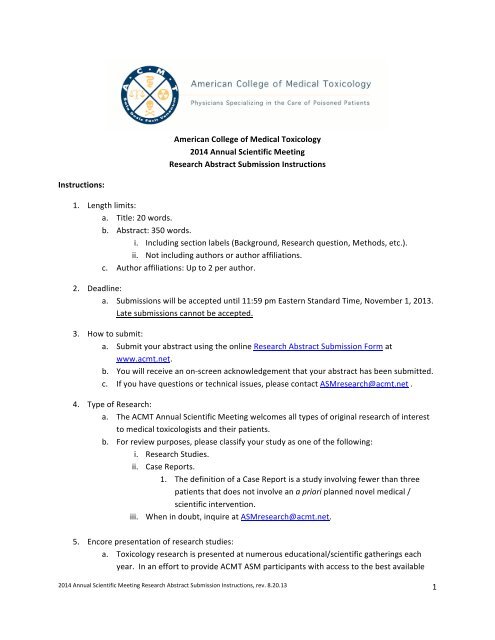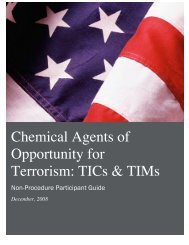1 American College of Medical Toxicology 2014 Annual Scientific ...
1 American College of Medical Toxicology 2014 Annual Scientific ...
1 American College of Medical Toxicology 2014 Annual Scientific ...
- No tags were found...
You also want an ePaper? Increase the reach of your titles
YUMPU automatically turns print PDFs into web optimized ePapers that Google loves.
new research, the ACMT ASM supports “encore presentation” <strong>of</strong> Research Studies that have been presented at other scientific meetings, subject to the following policies: i. All prior presentation must be disclosed at the time <strong>of</strong> abstract submission (see examples) 1. This includes prior presentation <strong>of</strong> partial / preliminary results. ii. Prior presentation concerns presentation at a national or international meeting. 1. Presentation at local or regional meetings does not constitute prior presentation. iii. Research Studies presented (or scheduled for presentation) between March 18, 2013 and March 28, <strong>2014</strong>, are eligible for encore presentation 1. Case Reports are not eligible for encore presentation 2. Research Studies presented on/before March 17, 2013 are not eligible for encore presentation. b. When in doubt, inquire at ASMresearch@acmt.net. 6. Prior publication: a. Studies that have been (or are scheduled to be) fully published (manuscript form, including electronic publication) prior to March 28, <strong>2014</strong> are not eligible for presentation at ACMT ASM b. Research that has been published in abstract form only is eligible for presentation. i. For copyright reasons, previously published abstracts will be acknowledged in the Journal <strong>of</strong> <strong>Medical</strong> <strong>Toxicology</strong> with the abstract reference, but cannot be republished. c. When in doubt, inquire at ASMresearch@acmt.net. 7. Style: a. Structure: All original research and previously published original research abstracts should contain the following sections, underlined in the text: i. Background: 1 – 2 sentences explaining why the research is needed. ii. Hypothesis or Research question: 1 sentence explaining the key question your study proposes to answer. 1. Optional (but encouraged) for case reports iii. Methods: Succinctly describe your study methods. 1. Begin with a statement <strong>of</strong> your research type (e.g. this is a randomized clinical trial; this is a consecutive-‐patient case series; this is a convenience sample survey; this is a case report). 2. Include setting/data source, method <strong>of</strong> obtaining data, and statistical analyses used. 3. Even a case report should have basic methods! See example #2. iv. Results: Present your key results. 1. Statements such as “results will be presented at the meeting” are not acceptable. <strong>2014</strong> <strong>Annual</strong> <strong>Scientific</strong> Meeting Research Abstract Submission Instructions, rev. 8.20.13 2
<strong>American</strong> <strong>College</strong> <strong>of</strong> <strong>Medical</strong> <strong>Toxicology</strong> <strong>2014</strong> <strong>Annual</strong> <strong>Scientific</strong> Meeting EXAMPLE 1 (Research Study) Page 1 <strong>of</strong> 2 Title Corresponding author name Email address for all correspondence Type <strong>of</strong> Research (Research Study or Case Report) First Author (e.g. Rumack BH) First Author affiliations (e.g. University <strong>of</strong> Maine, Portland, ME) Second Author Second Author affiliations Third Author Third Author affiliations Fourth Author Fourth Author affiliations Fifth Author Fifth Author affiliations Sixth Author Sixth Author affiliations Are there more than six authors?(If so, write “yes” and attach a complete author list) Word Count (abstract only) Has this work been previously presented? List all previous presentations <strong>of</strong> this work, including abstracts Will this work be published in manuscript form before March 17, 2013? (Yes or No) List all funding sources for this work What IRB/IACUC approved this study (If Exempt, write “Exempt”) “I certify that this work conforms to the ICMJE Authorship and Contributorship requirements” Does Acetaminophen Poisoning Increase Risk <strong>of</strong> Allergy to Cats? Bruce Lee karateguy@hongkong.net Research Study Lee BJ University <strong>of</strong> San Francisco, San Francisco, CA Davidson H University <strong>of</strong> Northern South Dakota, Sturgiss, SD n/a No 245 Yes Platform presentation at ASPCA <strong>Annual</strong> <strong>Scientific</strong> Meeting, Catalina Island, CA, December 12, 2013; abstract published in ASPCA Journal, November 2013 No Internally funded UCSF IACUC approved Yes
<strong>American</strong> <strong>College</strong> <strong>of</strong> <strong>Medical</strong> <strong>Toxicology</strong> <strong>2014</strong> <strong>Annual</strong> <strong>Scientific</strong> Meeting EXAMPLE 1 (Research Study) Page 2 <strong>of</strong> 2 Title Abstract text Does Acetaminophen Poisoning Increase Risk <strong>of</strong> Allergy to Cats?Background: Epidemiologic studies have reported an association betweenacetaminophen use and allergy/atopy. Allergy to house cats (F. catus) is acommon medical condition. It is not known whether exposure to acetaminophenin overdose increases the risk <strong>of</strong> subsequently developing house cat allergy.Research question: Are acetaminophen overdose patients at increased risk <strong>of</strong>developing allergy to house cats? Methods: This is a retrospective study <strong>of</strong>consecutive patients presenting to a tertiary care hospital, and age/sex-matchedcontrols. A search <strong>of</strong> our hospital’s electronic medical record system (1992 –September 1, 2011) was used to identify all patients discharged alive followinghospital admission for acetaminophen overdose. Each case was age- and sexmatched2:1 to control patients admitted for an overdose to a nonacetaminophenpharmaceutical product. An event was defined as any inpatientor outpatient encounter containing an ICD-9 code-family notation for asthma orallergic conditions and the word, “cat,” in the provider notes field. Subjects werecensored 24 months after their last encounter in our system. Cox proportionalhazards analysis was used to evaluate time-to-event. Results: A total <strong>of</strong> 84patients admitted for acetaminophen overdosage were matched to 142 controls.During a median <strong>of</strong> 16 months <strong>of</strong> follow-up, 17 acetaminophen overdose patientsand 12 controls developed cat allergy (HR: 2.5; 95% CI: 1.2 – 6.8; P = 0.02, CoxPH) Discussion: Our analysis was unable to control for prior or subsequentacetaminophen use. Conclusion: Patients who overdose on acetaminophen maybe at increased risk <strong>of</strong> subsequent developing house cat allergy.
<strong>American</strong> <strong>College</strong> <strong>of</strong> <strong>Medical</strong> <strong>Toxicology</strong> <strong>2014</strong> <strong>Annual</strong> <strong>Scientific</strong> Meeting EXAMPLE 2 (Case Report) Title Corresponding author name Email address for all correspondence Type <strong>of</strong> Research (Research Study or Case Report) First Author (e.g. Rumack BH) First Author affiliations (e.g. University <strong>of</strong> Maine, Portland, ME) Second Author Second Author affiliations Third Author Third Author affiliations Fourth Author Fourth Author affiliations Fifth Author Fifth Author affiliations Sixth Author Sixth Author affiliations Are there more than six authors?(If so, write “yes” and attach a complete author list) Word Count (abstract only) Has this work been previously presented? List all previous presentations <strong>of</strong> this work, including abstracts Will this work be published in manuscript form before March 17, 2013? (Yes or No) List all funding sources for this work What IRB/IACUC approved this study (If Exempt, write “Exempt”) “I certify that this work conforms to the ICMJE Authorship and Contributorship requirements” Page 1 <strong>of</strong> 2 Neutoprolol Extraction During High-‐Flux Hemodialysis Bruce Wayne imbatman@gotham.edu Case report Wayne B Gotham Technical University, Gotham City, NY Grayson R Gotham Technical University, Gotham City, NY Pennyworth A University <strong>of</strong> the Virgin Islands, Charlotte Amilie, USVI n/a No 271 Yes None No None Exempt Yes
<strong>American</strong> <strong>College</strong> <strong>of</strong> <strong>Medical</strong> <strong>Toxicology</strong> <strong>2014</strong> <strong>Annual</strong> <strong>Scientific</strong> Meeting EXAMPLE 2 (Case Report) Page 2 <strong>of</strong> 2 Title Abstract text Neutoprolol Extraction During High-Flux HemodialysisBackground: Neutoprolol is a new beta-receptor antagonist that produces lifethreateningtoxicity in overdose. It is not previously known whether neutoprolol isremoved by hemodialysis. Hypothesis: High-flux hemodialysis increasesclearance <strong>of</strong> neutoprolol compared with native elimination alone. Methods: Thisis a single patient chart review. A 42 year old woman with a history <strong>of</strong>hypertension ingested 28,000 mg <strong>of</strong> neutoprolol in a suicide attempt.Hypotension and bradycardia were refractory to therapy with glucagon,norepinephrine, and high dose insulin. High flux hemodialysis was initiated 7.2hours after ingestion. Timed serum neutoprolol levels were obtained before,during, and after hemodialysis as part <strong>of</strong> routine clinical care. In addition, inletand outlet neutoprolol levels were obtained from the dialysis circuit. Dialysis wasperformed using a Frensius 2008K machine and a Markum 6000 cellulosetriacetate membrane. Pharmacokinetic calculations were made using SummitPK.Results: Three pre-dialysis, four intra-dialysis, and two post-dialysis serumneutoprolol measurements were obtained. All demonstrated first-orderelimination kinetics. The serum half-life <strong>of</strong> neutoprolol was 8.4 hours pre-dialysis,1.2 hours during dialysis, and 7.2 hours post-dialysis. Dialysis clearance <strong>of</strong>neutoprolol was 65 mL/min. At a time when the serum neutoprolol level was 78.5mcg/mL, dialysis extraction <strong>of</strong> neutoprolol was 15.7 mg/min. Following 6 hours <strong>of</strong>dialysis, the patient was weaned from vasopressor support. She recovered fullyand was transferred to psychiatry on 4 days after ingestion. Discussion: Althoughthis study shows that dialysis increases neutoprolol elimination, whether thistranslates to clinical benefit is unproven. Because protein binding <strong>of</strong> neutoprololis inversely related to serum levels, these results may not apply to the chroniccare setting. Conclusion: High flux hemodialysis effectively removes neutoprololunder overdose conditions.
<strong>American</strong> <strong>College</strong> <strong>of</strong> <strong>Medical</strong> <strong>Toxicology</strong> <strong>2014</strong> <strong>Annual</strong> <strong>Scientific</strong> Meeting EXAMPLE 3 (Case Report) Title Corresponding author name Email address for all correspondence Type <strong>of</strong> Research (Research Study or Case Report) First Author (e.g. Rumack BH) First Author affiliations (e.g. University <strong>of</strong> Maine, Portland, ME) Second Author Second Author affiliations Third Author Third Author affiliations Fourth Author Fourth Author affiliations Fifth Author Fifth Author affiliations Sixth Author Sixth Author affiliations Are there more than six authors?(If so, write “yes” and attach a complete author list) Word Count (abstract only) Has this work been previously presented? List all previous presentations <strong>of</strong> this work, including abstracts Will this work be published in manuscript form before March 17, 2013? (Yes or No) List all funding sources for this work What IRB/IACUC approved this study (If Exempt, write “Exempt”) “I certify that this work conforms to the ICMJE Authorship and Contributorship requirements” Page 1 <strong>of</strong> 2 Laszlomonium Ingestion with Serum levels Miguel Phelps mphelps@ACMT generalhospital.org Case report Phelps M ACMT General Hospital, Phoenix, AZ Gaanes R ACMT General Hospital, Phoenix, AZ No 196 No No None Exempt Yes
<strong>American</strong> <strong>College</strong> <strong>of</strong> <strong>Medical</strong> <strong>Toxicology</strong> <strong>2014</strong> <strong>Annual</strong> <strong>Scientific</strong> Meeting EXAMPLE 3 (Case Report) Page 1 <strong>of</strong> 2 Title Abstract text Laszlomonium Ingestion with Serum LevelsBackground: Laszlomonium is a novel therapy with FDA indications to preventhydrophobia. There is no experience with overdose <strong>of</strong> this drug. Hypothesis: Wehypothesize that symptoms following acute overdose should correlate with serumlevels. Methods: This is a single patient chart review. A 76 year old male with ahistory <strong>of</strong> dementia and diabetes accidentally ingested 5,000 mg <strong>of</strong> his son’slaszlomonium. Within two hours, he developed repeated episodes <strong>of</strong> vomiting,myoclonic jerking, and then coma. Naloxone and flumazenil were administeredwithout effect. The patient was intubated and mechanically ventilated. The comapersisted for 48 hours at which point he rapidly awoke. Serum was obtainedevery 12 hr and laszlomonium levels were determined via GC-massspectroscopy using methylated-laszlomonium as a standard. Results: Levelsappear in the table. Discussion: This case <strong>of</strong> acute ingestion presented withunexpected findings <strong>of</strong> myoclonus and prolonged coma. Laszlomonium isreportedly metabolized via mixed hepatic oxidase enzymes, has a therapeuticserum range <strong>of</strong> 10-15 mg/L, and has a elimination T1/2 <strong>of</strong> 6 hr. The pattern <strong>of</strong>serum levels suggests enzyme saturation. Levels correlated with duration <strong>of</strong>coma. Conclusion: Coma may occur following laszlomonium ingestion and druglevels correlated with duration <strong>of</strong> symptoms.Table: Laszlomonium Levels vs. Time Post-‐Ingestion (PI) Time PI 6 hr 12 hr 24 hr 36 hr 48 hr 60 hr 72 hr Level mg/L 28.7 32.0 29.4 30.5 16.0 8.0 undetectable
















